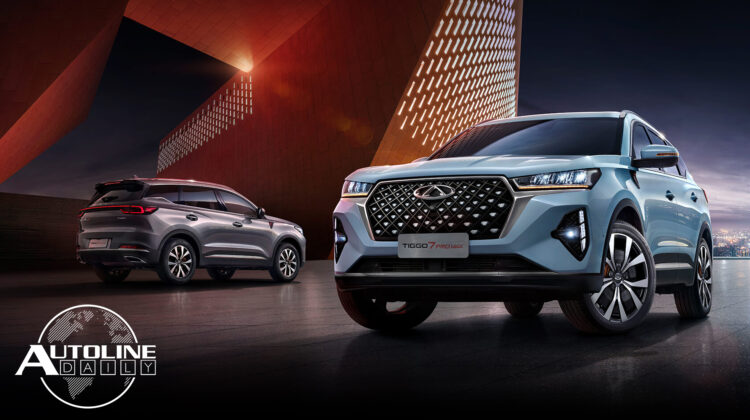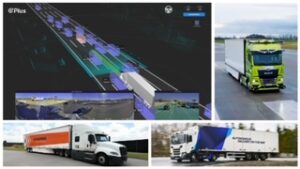
Follow us on social media:
Runtime: 8:33
0:00 Italy In Talks with Chery To Build Vehicles in The Country
1:22 Auto Execs Say SDVs Still a Ways Off
2:28 Tesla Restarts Berlin Production
2:52 GM Loses Two Top Executives
4:16 Nissan Could Build Fisker’s Alaska Truck in Mississippi
5:53 BYD Has Ambitious Growth Plans in Europe
6:44 Toyota & Nissan Boost Wages in Japan
7:25 VW To Launch L4 Semi-Trucks in U.S. & EU
Visit our sponsor to thank them for their support of Autoline Daily: Bridgestone and Intrepid Control Systems.
This is Autoline Daily, the show dedicated to enthusiasts of the global automotive industry.
ITALY IN TALKS WITH CHERY TO BUILD VEHICLES IN THE COUNTRY
Italy is not shy about wanting to expand vehicle production in the country. Fiat is the only major automotive producer in Italy, building about 750,000 vehicles last year. But country officials want to boost that output to 1.3 million a year. So, Italy pushed Fiat to significantly increase production, even toying with the idea of taking a stake in parent company Stellantis to get what it wanted. Stellantis eventually agreed to raise production by an additional 250,000 units to roughly 1 million vehicles a year. That means Italy would like to find someone to make 300,000 more vehicles a year in the country and it has a 6-billion-euro war chest for supporting local auto manufacturing as a way of luring in another automaker. And according to a report in Reuters, Chinese automaker Chery is the one Italy is “betting on most.” While we’ve seen opposition to Chinese automakers in Europe, it mostly seems to be related to cheaper EV imports. There’s less pushback on domestic production and Italy wants all the jobs it will create.
AUTO EXECS SAY SDVs STILL A WAYS OFF
Software Defined Vehicle or SDV is a pretty buzzy word you’re likely to hear even if you only pay attention to the auto industry a little bit. These are vehicles where pretty much every function is controlled by software and can be updated. Every automaker is working on them, with some changing entire development philosophies, now designing a car from the inside out, around the software. But SDVs might not be as close to market-ready as you might think. Chip maker NXP Semiconductor and Wards Intelligence surveyed automotive executives from around the globe and say a majority of them don’t think at least 50% of new vehicles will be Software Defined before 2030. The biggest hurdles seem to be building a team that can develop a competent system and having to deal with legacy electronic architectures. But most automakers have already started laying the groundwork for full Software Defined Vehicles and some are clearly ahead of others.
TESLA RESTARTS BERLIN PRODUCTION
Tesla’s plant in Berlin is up and running again after an arson attack at a nearby power station last week shut it down. Germany’s Handlesblatt newspaper reports that Tesla was unable to build about 8,000 vehicles during the stoppage and will cost the company 400 million euros. Elon Musk also visited the plant today for the restart of production.
GM LOSES TWO TOP EXECUTIVES
General Motors is losing a couple of its top executives. The company announced that Gerald Johnson, the global head of manufacturing is retiring after 44 years with GM but he’ll remain at the company through the end of the year to help with the transition. Replacing Johnson is JP Clausen, who GM says has “vast expertise in global manufacturing, product engineering and scaling operations.” Clausen spearheaded the scaling up of EV propulsion systems at Tesla’s Gigafactory 1 and he’s also worked at Google, LEGO and biomanufacturing company Zymergen. GM also announced that its head of software, Mike Abbott, is leaving the company due to health reasons. GM poached Abbott last year from Apple and CEO Mary Barra has credited him with helping to turnaround its software development. GM’s VP of software, Baris Cetinok, will run the division on an interim basis.
NISSAN COULD BUILD FISKER’S ALASKA TRUCK IN MISSISSIPPI
We’ve got some great production updates from Autoforecast Solutions. It says Cadillac is working on an all-electric sedan that would like an EV version of the CT4 or CT5. So, a lot cheaper than the Celestiq. It’s said to be built on a version of the Ultium platform for more premium light duty cars and crossovers, called BEV Prime and would go into production at GM’s Lansing Grand River plant in August of 2028. There’s also an update on Lucid’s plans to build vehicles in Saudi Arabia. If you didn’t know, Lucid is majority owned by the Saudi Public Investment Fund and in 2022 announced plans to start production of a local plant later that year. At first it plans to make about 5,000 cars a year from pre-assembled kits that are put together at its plant in Arizona. But it will eventually become a full domestic manufacturer, which will likely happen when it launches the Gravity SUV and a smaller CUV. That CUV is said to start production in Saudi Arabia in June of 2026, followed by the U.S. in August. Lastly, you may have seen rumors that Nissan is in talks with Fisker, some reports specifically saying it’s interested in the Alaska pickup truck. I personally would be surprised if it happened, but Autoforecast says if it does, the electric pickup would be made at one of Nissan’s U.S. plants in Mississippi.
BYD HAS AMBITIOUS GROWTH PLANS IN EUROPE
BYD’s sales in Europe are still relatively low but it plans to aggressively grow them over the next few years. The automaker, which launched in the EU in 2021, sold less than 16,000 vehicles last year, all of which were pure electrics. That accounted for 1.1% of the European EV market. But BYD’s head of Europe tells Automotive News that it wants to boost that to 5% or about 70,000 EVs, before it starts production at a new plant in Hungary around 2026. That plant will have an initial capacity of 150,000 vehicles, which could be doubled to 300,000 units and BYD believes the European plant will help it gain more customer acceptance in the market.
TOYOTA & NISSAN BOOST WAGES IN JAPAN
Major automakers in Japan like Toyota and Nissan are fully agreeing to union demands for pay raises that are the largest in 25 years. Toyota workers will get nearly $200 more a month and it will also give out record bonus payments. Last year those bonuses were said to be equal to more than 6 months of pay, but that’s likely going up to over 7.5 months. This should allow the Bank of Japan to end negative interest rates, which kept the yen weak, but also turbocharged the earnings of most Japanese companies. Now it looks like workers will get a piece of that pie.
VW TO LAUNCH L4 SEMI-TRUCKS IN U.S. & EU
Volkswagen’s commercial truck subsidiary, the Traton Group, which includes Navistar, Scania and MAN, is partnering up with autonomous driving software developer, Plus, to launch Level 4 autonomy. The companies are already testing self-driving trucks on public roads in the U.S. and Europe with a safety driver on board. This year, they plan to pilot commercial operations with fleets. Then they will start series production and global deployment at scale.
But that brings us to the end of today’s show. Thanks for making Autoline a part of your day.
Thanks to our partner for embedding Autoline Daily on its website: WardsAuto.com







Happy Pi Day everyone
Cake available at 3:14 for PI day
Here is what I don’t get with the SDVs, OEMs have not forgotten how to build vehicles right? At the end of the day, EVs are vehicles with a different power train, right? So they current have the tech to build EVs with current applications, just not all the the tech that maybe a Tesla, Rivian or Lucid may have. It just seems that the advantages that those EV startups have, are not fully usable and are currently under development by those OEMs as well! I get that they may be farther along, but, for the most part, that advantage is not some that the public can take full advantage of, even though the company has laid the groundwork for its use in the future. I know that those in the industry and who have seen what is going on behind the scenes, have said how far Tesla is ahead of others, especially the the legacy OEMs. Yet, on the street, I don’t see the large gap between the Cybertruck, Lightning, R1T, Silverado EV, Hummer SUT and REV?! The Cybertruck and the R1T maybe better equipped to adapt to what comes next, but if you look at Tesla’s track record with the Model S, it may receive little to no updates during its life time and only incremental future development at best! That may speak volumes of the design of the vehicle’s hard and software, that it is so far advanced and robust enough, to remain current and further developed, that it is still ahead of the game after nearly 15 plus years! Yet, the Model S is a car, you get into it, start it and drive to your destination. It still can’t safely drive itself or passengers and any up dates have been gradual overtime! So, outside of a different power train, how much different is it then anything else on the road? The current break through has been that EVs are now at a point that, for most daily chores, they can compete with ICE vehicles on the premium to luxury side of things. IMHO, the next big break through will not be SDVs, but getting the cost and weight down so the the average buyer can afford them!
SDV adds cost to a vehicle and I can’t see why OEMs would focus on that first/more then putting emphasis to bringing the EV other big cost down first, before moving to full SDV. case and point, the Model 3. The Model 3 does not have all the things that the Model S has, a lot of that having to do with the cost point that Tesla was shooting for. So, what can we expect from the often rumored “Model2”? While it may benefit from gigcasting and the like, does it seem likely to get AutoPilot or FSD? That software would add cost, especially with the cost of those items alone being 2/3s of the cost of the vehicle with out it. It’s battery will no doubt be smaller and I wouldn’t be surprised if it only had 250 miles of range between chargers. While not a bad thing, getting the cost down and range up may inhibit the cost of expensive software. Another example, is the EX30 vs the EX90. I don’t recall a version of the EX30, coming with the ladars and other tech the EX90 will have, to enable it to drive for itself. Again, IMHO, the big hurdle to EV adoption by the general, is the cost and perceived range inadequacies. SDV, as seen in this report, legacy OEMs are behind, but, while upstarts may be ahead, not so much so that it is readily apparent to the public. Much of where the upstarts are ahead, most legacy OEMs can address with their larger dealership service network. Some of that service, dealership have sent technicians out to an owners home or job to address, as an added convenience.